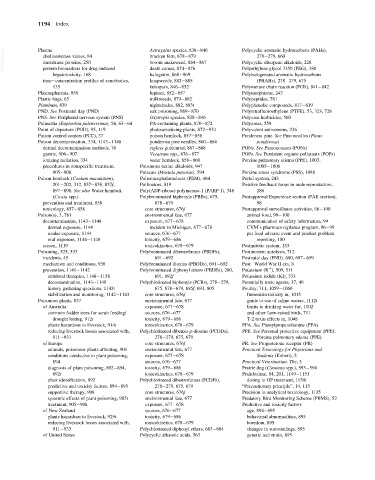Page 1263 - Veterinary Toxicology, Basic and Clinical Principles, 3rd Edition
P. 1263
1194 Index
VetBooks.ir Plasma Astragalus species, 838 846 Polycyclic aromatic hydrocarbons (PAHs),
cholinesterase values, 84
bracken fern, 878 879
278 279, 660
membrane proteins, 250
Polycyclic diterpene alkaloids, 228
broom snakeweed, 864 867
protein biomarkers for drug-induced
hepatotoxicity, 168 death camas, 874 876 Polyethylene glycol 3350 (PEG), 380
Polyhalogenated aromatic hydrocarbons
halogeton, 868 869
time concentration profiles of xenobiotics, knapweeds, 882 885 (PHAHs), 278 279, 675
135 larkspurs, 846 852 Polymerase chain reaction (PCR), 841 842
Plasmapharesis, 958 lupines, 852 857 Polymorphisms, 243
Plastic bags, 65 milkweeds, 879 882 Polypeptides, 781
Plumbum, 439 nightshades, 882, 883t Polyphenolic compounds, 817 819
PND. See Postnatal day (PND) oak poisoning, 869 870 Polytetrafluoroethylene (PTFE), 53, 323, 728
PNS. See Peripheral nervous system (PNS) Oxytropis species, 838 846 Polyurea herbicides, 560
Poinsettia (Euphorbia pulcherrima), 54, 63 64 PA-containing plants, 870 872 Polyureas, 559
Point of departure (POD), 95, 119 photosensitizing plants, 872 874 Polyvalent antivenoms, 236
Poison control centers (PCC), 37 poison hemlock, 857 858 Ponderosa pine. See Pine needles (Pinus
Poison decontamination, 334, 1143 1148 ponderosa pine needles, 860 864 ponderosa)
dermal decontamination methods, 76 rayless goldenrod, 867 868 PONs. See Paraoxonases (PONs)
gastric, 906 907 Veratrum spp., 876 877 POPs. See Persistent organic pollutants (POPs)
ionizing radiation, 334 water hemlock, 858 860 Porcine pulmonary edema (PPE), 1003,
procedures in nonspecific treatment, Poisonous taxine alkaloids, 947 1005 1006
905 906 Polecats (Mustela putorius), 594 Porcine stress syndrome (PSS), 1088
Poison hemlock (Conium maculatum), Polioencephalomalacia (PEM), 484 Portal system, 243
201 202, 312, 857 858, 857f, Pollinators, 819 Positive feedback loops in male reproduction,
897 898. See also Water hemlock Poly(ADP-ribose) polymerase-1 (PARP 1), 348 286
(Cicuta spp.) Polybrominated biphenyls (PBBs), 675, Postapproval Experience section (PAE section),
prevention and treatment, 858 678 679 98
toxicology, 857 858 core structures, 676f Postapproval surveillance activities, 96 100
Poison(s), 3, 781 environmental fate, 677 animal food, 99 100
decontamination, 1143 1148 exposure, 677 678 communication of safety information, 99
dermal exposure, 1144 incident in Michigan, 677 678 CVM’s pharmacovigilance program, 96 99
ocular exposure, 1144 sources, 676 677 pet food adverse event and product problem
oral exposure, 1144 1148 toxicity, 679 686 reporting, 100
screen, 1119 toxicokinetics, 678 679 Postmitotic system, 153
Poisoning, 525, 533 Polybrominated dibenzofurans (PBDFs), Postmortem autolysis, 712
incidents, 45 691 692 Postnatal day (PND), 680, 697 699
mechanism and conditions, 938 Polybrominated dioxins (PBDDs), 691 692 Post World War II era, 8
1
prevention, 1141 1142 Polybrominated diphenyl ethers (PBDEs), 280, Potassium (K ), 509, 511
antidotal therapies, 1148 1158 691, 692f Potassium iodide (KI), 333
decontamination, 1143 1148 Polychlorinated biphenyls (PCBs), 278 279, Potentially toxic agents, 37, 40
history gathering questions, 1143t 675, 678 679, 685f, 691, 805 Poultry, 711, 1059 1060
stabilization and monitoring, 1142 1143 core structures, 676f fumonisin toxicity in, 1015
Poisonous plants, 837 environmental fate, 677 guide to use of saline waters, 1112t
of Australia exposure, 677 678 limits in drinking water for, 1102
common fodder trees for scrub feeding/ sources, 676 677 and other farm-raised birds, 711
drought lotting, 912t toxicity, 679 686 T-2 toxin effects in, 1048
plants hazardous to livestock, 914t toxicokinetics, 678 679 PPA. See Phenylpropanolamine (PPA)
reducing livestock losses associated with, Polychlorinated dibenzo-p-dioxins (PCDDs), PPE. See Personal protective equipment (PPE);
911 933 278 279, 675, 679 Porcine pulmonary edema (PPE)
of Europe core structures, 676f PR. See Progesterone receptor (PR)
animals, poisonous plants affecting, 901 environmental fate, 677 Practical Toxicology for Physicians and
conditions conducive to plant poisoning, exposure, 677 678 Students (Kobert), 5
894 sources, 676 677 Practical Veterinarian, The,5
diagnosis of plant poisoning, 892 894, toxicity, 679 686 Prairie dog (Cynomys spp.), 593 594
892t toxicokinetics, 678 679 Pralidoxime, 84, 201, 1149 1151
plant identification, 892 Polychlorinated dibenzofurans (PCDFs), dosing in OP treatment, 1150t
predictive and toxicity factors, 894 895 278 279, 675, 679 “Precautionary principle”, 14, 115
supportive therapy, 908 core structures, 676f Precision in analytical toxicology, 1135
systemic effects of plant poisoning, 905t environmental fate, 677 Predatory Bird Monitoring Scheme (PBMS), 52
treatment, 905 908 exposure, 677 678 Predictive and toxicity factors
of New Zealand sources, 676 677 age, 894 895
plants hazardous to livestock, 929t toxicity, 679 686 behavioral abnormalities, 895
reducing livestock losses associated with, toxicokinetics, 678 679 boredom, 895
911 933 Polychlorinated diphenyl ethers, 683 684 changes in surroundings, 895
of United States Polycyclic alkanoic acids, 563 genetic and strain, 895

